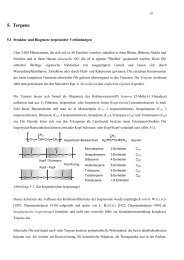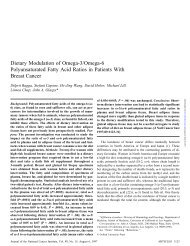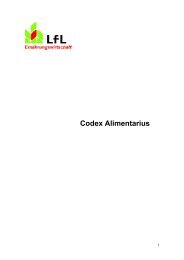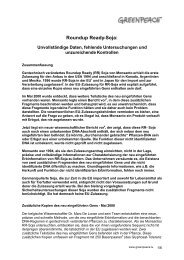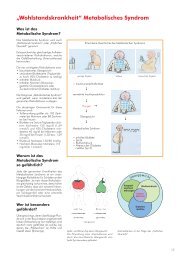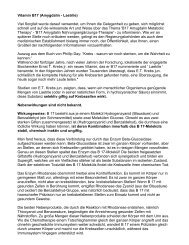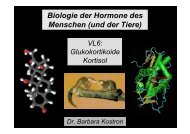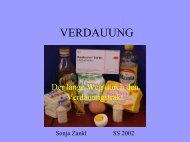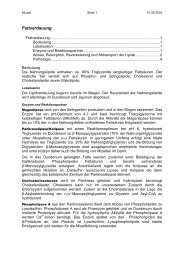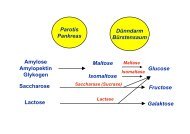Genmanipulation - Zentrum der Gesundheit
Genmanipulation - Zentrum der Gesundheit
Genmanipulation - Zentrum der Gesundheit
Erfolgreiche ePaper selbst erstellen
Machen Sie aus Ihren PDF Publikationen ein blätterbares Flipbook mit unserer einzigartigen Google optimierten e-Paper Software.
96<br />
95. Ho MW, Ryan A, Cummins J and Traavik T. Slipping through the regulatory net.<br />
‘Naked’ and ‘free’ nucleic acids. TWN Biotechnology & Biosafety Series 5, Third World<br />
Network, Penang 2001.<br />
96. Stemmer WPC. Molecular breeding of gene, pathways and genomes by DNA<br />
shuffling. Journal of Molecular Catalysis B: Enzymatic 2002, 19-20, 2-12.<br />
97. Ho MW. Death by DNA shuffling. ISIS Report, April 2003; also Science in Society<br />
2003, 18, 9, www.i-sis.org.uk<br />
98. Ho MW, Ryan A and Cummins J. Cauliflower mosaic viral promoter - A recipe for<br />
Disaster? Microbial Ecology in Health and Disease 1999, 11, 194-7.<br />
99. Hodgson J. Scientists avert new GMO crisis. Nature Biotechnology 2000, 18, 13.<br />
100. Cummins J, Ho MW and Ryan A. Hazardous CaMV promoter? Nature<br />
Biotechnology 2000, 18, 363.<br />
101. Hull R, Covey SN and Dale P. Genetically modified plants and the 35S promoter:<br />
Assessing the risks and enhancing the debate. Microbial Ecology in Health and<br />
Disease 2000, 12, 1-5.<br />
102. Ho MW, Ryan A and Cummins J. Hazards of transgenic plants with the<br />
cauliflower mosaic viral promoter. Microbial Ecology in Health and Disease 2000, 12,<br />
6-11.<br />
103. Courtail B, Fenebach F, Ebehard S, Rhomer L, Chiapello H, Carilleri C and Lucas<br />
H. Tnt 1 transposition events are induced by in vitro transformation of Arabidopsis<br />
thaliana, and transposed copies integrated into genes. Mol. Gen. Genomics 2001,<br />
265, 32-42.<br />
104. Ho MW, Ryan A and Cummins J. CaMV35S promoter fragmentation hotspot<br />
confirmed and it is active in animals. Microbial Ecology in Health and Disease 2000,<br />
12, 189.<br />
105. The Advisory Committee on Releases to the Environment’s (ACRE’s) response to<br />
concerns raised in written representation and submissions associated with the<br />
CHARDON LL public hearing and to statements made at ACRE’s open hearing<br />
relating to the safety assessment of T25 GM maize conducted un<strong>der</strong> Directive<br />
90/220/EEC, www.defra.gov.uk/environment/acre<br />
106. Metz M and Futterer J. Suspect evidence of transgenic contamination. Nature,<br />
Advance Online Publication, 4 April 2002, www.nature.com; see also Ho MW.<br />
Astonishing denial of transgenic pollution. Science in Society 2002, 15, 13-14; fully<br />
referenced version on ISIS members' website, www.i-sis.org.uk<br />
107. Bergelson J, Purrington CB and Wichmann G. Promiscuity in transgenic plants.<br />
Nature 1998, 395, 25.<br />
108. De Vries J, and Wackernagel W. Detection of nptII (kanamycin resistance) genes<br />
in genomes of transgenic plants by marker-rescue transformation. Mol. Gen. Genet.<br />
1998, 257, 606-13.<br />
109. Schluter K, Futterer J and Potrykus I. Horizontal gene-transfer from a transgenic<br />
potato line to a bacterial pathogen (Erwinia chrysanthem) occurs, if at all, at an<br />
extremely low-frequency. BioTechnology 1995, 13, 1094-8.<br />
110. Gebhard F and Smalla K. Monitoring field releases of genetically modified sugar<br />
beets for persistence of transgenic plant DNA and horizontal gene transfer. FEMS<br />
Microbiol. Ecol. 1999, 28, 261-72.<br />
111. Mercer DK, Scott KP, Bruce-Johnson WA, Glover LA. and Flint HJ. Fate of free<br />
DNA and transformation of the oral bacterium Streptococcus gordonii DL1 by plasmid<br />
DNA in human saliva. Applied and Environmental Microbiology 1999, 65, 6-10.<br />
112. Duggan PS, Chambers PA, Heritage J and Forbes JM. Survival of free DNA<br />
encoding antibiotic resistance from transgenic maize and the transformation activity of<br />
DNA in ovine saliva, ovine rumen fluid and silage effluent. FEMS Microbiology Letters



